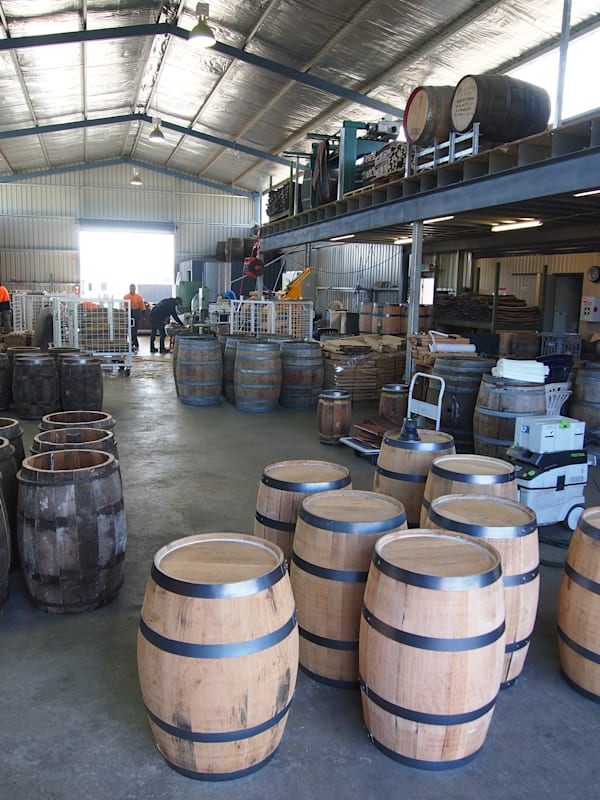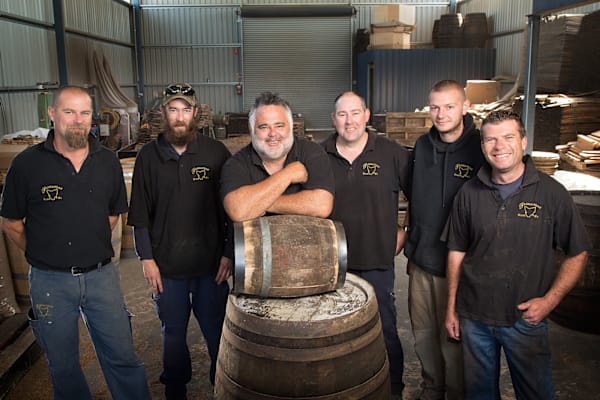Adam Bone was a stonemason in 1997 when he began learning the art, at a small cooperage in the Huon Valley, of making the perfect cask. Eventually, he decided to buy the business, figuring if he could complete two or three casks a week he would be able to sustain himself.
Not long after this decision, the Tasmanian whisky industry went through a growth spurt. Now Bone’s Tasmanian Cask Company employs nine people at the factory in Bridgewater and supplies casks to premium whisky and spirit producers across Tasmania, Australia and even Scotland.
The value of a barrel is its story: what it is made from, what it has contained and for how long, where it has come from, and how it has been manipulated by the cooper.
French and American oak are generally the chosen timbers. They have the right grain and density to enable both the absorbing and the giving of taste, and importantly, unlike many timbers, they don’t contain any toxins that can be harmful for consumption.
The “cask histories” most sought after for whisky are port, sherry, pinot noir and bourbon. The bourbon casks come mostly from the US, port and sherry are generally from the Barossa Valley and pinot casks come from various places. It is the sugars from these products that gradually soak into the oak and crystallise on, and within, the interior surface. Charring the inside of the casks reinforces this by caramelising these sugars into the charcoaled oak.

Sherry casks give a sweeter, more delicate flavour to whisky while port casks produce a heavier, Christmas pudding-type whisky. Bourbon casks produce Adam Bone’s favourite whiskies.
The endless profiles of flavour that can be created by adjusting all of these elements is what is so highly sought after by makers of fine spirits. Distillers and blenders are able to work with Bone and his team to develop casks with a very specific story and to ensure consistency across the number of casks required.
The timber and its story matters more than the cask itself. A 500-litre sherry cask, for example, can be used to make several 100-litre whisky casks. Small casks are important for the thriving whisky industry because the aging process occurs more rapidly in a small cask – there is more surface area of oak per volume of whisky.
The process involves cutting the tops and bottoms out of the casks, shaving and thinning the timber and pulling the individual pieces of oak apart. To re-size and reshape the timber into a new cask involves a process of steaming and bending under pressure, and finally the interior of the barrel is charred to optimise the aging process.
The Tasmanian Cask Company now supplies casks to Tasmanian producers Lark, Shene, William McHenry and Sons, Nant, Redlands and Sullivan’s Cove (2014 winner of the World’s Best Single Malt). They also create casks for the state’s growing range of other spirits such as gin, brandy and vodka, supply several mainland producers, and are becoming known overseas.
With the growth of fine spirits in Tasmania, and indeed across Australia, there is a now a large demand for the preparation of suitable casks. The Tasmanian Cask Company’s production has tripled in the past two years. Adam Bone’s original, fingers-crossed two or three casks a week is currently 13 casks a day, and planned expansion in 2017 should take the number to 20.

As the business has grown, so have the perks – he is regularly gifted bottles of the finest spirits, and he and his barrel-making team get to taste the final result of their efforts.
One of his biggest investments is in old casks. While demand for spirits is growing, demand for port and sherry is declining, meaning supply of port and sherry casks is falling. Adam Bone has seen a shortage coming and is getting ready. He has built a very large shed and is filling it with as many port and sherry casks as he can find. So far, he has 10,000.
In a way, they represent 10,000 stories. Casks have long, interesting and varied lives. Even after being used to make whisky, they may be only in middle-age. Some are used twice to make whisky, although this is rare because it takes about 50 per cent longer for the whisky for age the second time around. Others are sought after for the aging of boutique beers and ciders, adding yet another chapter to the flavours absorbed and re-gifted. Then, when they truly reach old age and retire from their work as a cask, they are recycled for use in interior design. And the shavings are perfect for smoking fish and meat.
So next time you sip a spirit or eat some smoked fish, think of the stories that might be speaking within that taste.
A publisher once told James that when he is asked for his bio, he should say: “James writes subversive essays about important things.” James felt a bit awkward about saying this publicly, but secretly he liked it. He has written for many publications. His books are Essays from Near and Far, Walleah Press, 2014 and The Balfour Correspondent, Bob Brown Foundation, 2017.
This article was first published in Issue 83 of Forty South print magazine.










